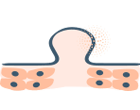Mohamed M, Kouwenberg D, Gardeitchik T, Kornak U, Wevers RA, Morava E. Metabolic cutis laxa syndromes. J Inherit Metab Dis. 2011 Aug. 34 (4):907-16.
Berk, D. R., Bentley, D. D., Bayliss, S. J., Lind, A., & Urban, Z. (2012). Cutis laxa: a review. Journal of the American Academy of Dermatology, 66(5), . https://doi.org/10.1016/j.jaad.2011.01.004
Mohamed, M., Voet, M., Gardeitchik, T., & Morava, E. (2014). Cutis Laxa. Advances in experimental medicine and biology, 802, 161–184. https://doi.org/10.1007/978-94-007-7893-1_11
Duque Lasio, M. L., & Kozel, B. A. (2018). Elastin-driven genetic diseases. Matrix biology : journal of the International Society for Matrix Biology, 71-72, 144–160. https://doi.org/10.1016/j.matbio.2018.02.021
Gupta, N., & Phadke, S. (2006). Cutis Laxa Type II and Wrinkly Skin Syndrome: Distinct Phenotypes. Pediatric Dermatology, 23(3), 225-230. doi: 10.1111/j.1525-1470.2006.00222.x





